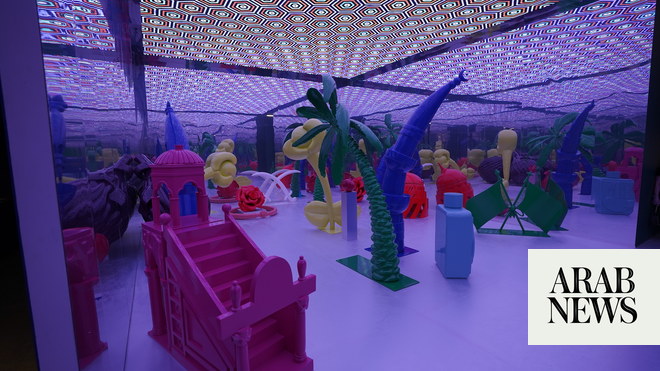
‘The Secrets of Alidades’ showcases 33 works from local and international artists
Nasser Al-Salem
For the latest updates, follow us on Instagram @arabnews.lifestyle
‘The First Space Shuttle’
The Saudi Art Council bills “The Secrets of Alidades” — which runs until September 7 — as an exhibition that “intertwines cartography and astronomy in an allegorical perspective.” The show’s name “alludes to the pointers found on astrolabes (among other astronomical instruments) that assist us in observing distant objects and determining directions.” So the work on display focuses on travel and exploration — whether physical or mental. Al-Salem’s Styrofoam, fabric and PVC sculpture presents arguably the clearest link to the title of any work on display. Al-Salem, an artist and calligrapher who was born into a family of tent salesmen in Makkah, “establishes a direct link between the ancient world of the Bedouins and … the conquest of space” with this work, according to the exhibition’s catalogue.
“Tents are associated with travel, mobility, and migration,” the artist explains. “As I see it, this idea of mobility creates a clear link between nomadic Bedouins and astronauts in their use of space, their engagement with nature, and their movement from one place to another.”
Yasmeen Sudairy and Rajaa Al-Hajj
‘Vertical Composition of Stratified Narratives’
Sudairy and Al-Hajj’s collaborative sculptures are made from found vehicle parts taken from impoundment lots. They are, the catalogue explains, “pop assemblages and part of a tradition that summons both the French sculptor César and his American counterpart John Chamberlain — but in a tradition remixed with Japanese manga.”
“Through this sculpture, we intend to articulate a unified vertical pillar by assembling dispersed, chaotic elements,” the artists say in their statement. “The theme of the piece reflects our psychological attraction to the continuous perceptual shift between the appearance of mechanic and organic forms, consisting of organized turbulences characterized by contrasts and rhythmic successions of colored curves and lines.”
Sara Ouhaddou
‘Al-Kalima’
The French-born Moroccan artist is heavily influenced by traditional craftsmanship and culture. This installation, made from recycled stained ‘Iraqi glass,’ brass and revolving motors, consists of five circular stained-glass windows covering a range of vibrancy — the colors gradually fading from one to the next. “It is a transformation that evokes the disappearance of (Iraqi glass) while what was likely Moorish glass replaced it — that is, before industrial glass was made in either China or Saudi Arabia,” the catalogue states. “In essence, these changes are an expression of standardization due to globalized production.
“At the same time, this fading material also marks the passage from complexity to nothingness.
‘Al-Kalima,’ which means ‘word’ in Arabic, is related to speech and its power … (The windows) emphasize the link between human language and the cosmos, following the calligraphic tradition,” it continues. Ouhaddou says that the piece is inspired by “the ideas and thoughts of the Arabic poets of enlightenment at the beginning of the 20th century.”
Mohammed Alsanie
‘The Past That Didn’t Occur’
Much of Alsanie’s work is a paean to the Eighties — soaked in neon and nostalgia, pitched, the catalogue suggests, “somewhere between the 1982 sci-fi classic ‘Tron’ and the crime series ‘Miami Vice.’” It continues: “Alsanie’s work is related to retrofuturism, where the future is perceived through filters of the past. Thus, technology already appears obsolete, becoming a vehicle for a certain nostalgia or melancholy.”
This video installation is essentially a walk through Jeddah (the local audience will likely recognize several of the city’s urban sculptures), but with several surrealist touches giving the whole thing an air of fantasy. “The abstract lines, the horizon, the setting sun, and the meteorites all transport the spectator into a mental universe where they can observe stellar elements on a street corner,” the catalogue says.
Moath Alofi
‘Cyprium 2135’
Much of Alothi’s work is inspired by the deserts of Saudi Arabia. This 10-meter-by-seven-meter print is no exception. It is, according to the catalogue, a reproduction of “a petroglyph of Jabal Uhain, depicting the arms and hands drawn on Jubbah mountain in the Ha’il Region. These last ‘mustatils,’ ancient stone structures visible in northwest Arabia, were sites of rituals that are unknown to us today.” Alothi then subtly alters those symbols “into a form reminiscent of the logos of the exhibition’s sponsors” and thus “creates a bridge between ancient times and our contemporary world.” The artist describes this work as an invitation to search for the “stars that exist on Earth as well as in the sky.”
Basheer Hawsawi
‘Untitled’
Hawsawi’s diorama is inspired by childhood memories of everyday objects from her family’s home, her father’s store, and in particular of the sight and scent of her mother drying lemons. The motorized lemon presses in the piece turn “without any function, calling to mind daily life and its repetitions,” the catalogue states. It continues: “The memory is linked to trauma — but trauma placed at a distance from reality.”
“I engage with time as a human being and artist in various ways,” Hawsawi says. “The past, to me, is like a quick journey where I don’t spend a lot of time, as it drains my present moment and my temporal existence.”
Nasser Almulhim
‘Gazing Into the Magical Universe’
Almulhim is best known for his abstract paintings, and this sculpture relies on many of the same influences. “Circles, rectangles, triangles, and other forms are visually embedded to create what Almulhim describes as a ‘spiritual icon,’” the catalogue says. The artist himself says the piece “may be regarded as a tool for communicating with our extraordinary universe and its magical beauty.”
“The work is rooted to the earth, yet it flows together with the energies above and below it, as though seeking other dimensions,” he writes. “It is a gateway to the search for beauty within and around us, a pathway allowing us to gaze … into the spirit.”











